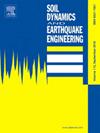Seismic fragility analysis of shield tunnels in liquefiable layered deposits
IF 4.2
2区 工程技术
Q1 ENGINEERING, GEOLOGICAL
引用次数: 0
Abstract
Ensuring the structural resilience of shield tunnels is critical in seismically active regions. Liquefaction induced by seismic activity poses an additional hazard to tunnel safety. The study performed seismic fragility analysis using the incremental dynamic analysis method which utilized a finite element model of a saturated porous seabed shield tunnel. The findings highlighted that different liquefaction mechanisms are observed in different types of the soil surrounding the tunnel. The thickness of the fine sand layer (FSL) surrounding the tunnel significantly affects seabed liquefaction depth and the tunnel's maximum bending moment (Mmax). The highest Mmax and damage probabilities were observed when the tunnel was entirely embedded in the FSL, whereas the smallest Mmax and lowest damage probabilities occurred when the tunnel was partially within the sand and clay. This study could also provide some insights on seismic mitigation strategies in subsea shield tunnels and the soil type influences the timing of Mmax occurrence and emphasized the critical role of seismic frequency in determining the tunnel's response.
求助全文
约1分钟内获得全文
求助全文
来源期刊

Soil Dynamics and Earthquake Engineering
工程技术-地球科学综合
CiteScore
7.50
自引率
15.00%
发文量
446
审稿时长
8 months
期刊介绍:
The journal aims to encourage and enhance the role of mechanics and other disciplines as they relate to earthquake engineering by providing opportunities for the publication of the work of applied mathematicians, engineers and other applied scientists involved in solving problems closely related to the field of earthquake engineering and geotechnical earthquake engineering.
Emphasis is placed on new concepts and techniques, but case histories will also be published if they enhance the presentation and understanding of new technical concepts.
 求助内容:
求助内容: 应助结果提醒方式:
应助结果提醒方式:


